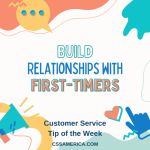
Having to get allergy shots once a week is never fun, and for Janet, it became an even bigger frustration.
She had the shots typically scheduled on Tuesday around 10:30 in the morning, figuring she would avoid the morning rush as well as the lunch rush by going mid-morning. However, that meant she had to leave work mid-morning for the appointment.
Long Wait, Short Staffed
The last two times she went to the doctor’s office, she had a long wait, not getting her shot until 30 minutes after the scheduled time. This day, she noticed there was only one person working the check-in desk and one person giving the shots (last month, there had been 2 of each), and that person giving the shots was also doing all the allergy testing. The employee was going 100 miles an hour, so Janet was not upset at him.
Janet could tell it was a staffing issue of some sort, so she asked the employee how to get in touch with the manager to discuss the wait. Janet didn’t want to get the employees in trouble for the delay, but she wanted to voice her displeasure, and she also thought she might help the staff by conveying to the manager the negative impact on the patients with these lower staffing levels.
The employee said that the manager wasn’t available then, but Janet was welcome to text the two managers who shared weekday responsibilities.
Two Ways to Text
So, Janet texted the two managers, noting the delay, how it appeared that staffing was lower than it had been a month ago, and noted that the staff that were there were doing a really good job. About 45 minutes later, the on-call manager replied: OK, I’ll get the schedulers to help find some help.
A few days later, Janet followed up with that co-manager to see if anything would be changing. There was no reply.
When Janet went back to the office for her shot the following week, she encountered the exact same issues with lower staffing and longer wait times. Again, she sent a text to the two managers, virtually the same as what she had sent the prior week except noting that this is the fourth straight week where this situation had occurred.
This time, the other co-manager replied within 10 minutes: Good morning, Ms. Smith. Thank you so much for your support and understanding. The staff are trying to do everything in their power to be on top of everything. We are working on the schedule and the staffing. For today, I’ve reached out to other team members to see if they can come in early to help with the delays.
True Story, Tip Lessons
These are actual texts from actual co-managers about actual situations that occurred in a healthcare setting. Yet the empathy conveyed was so different. The timeliness was so different. A statement on what long-term action would be taken was different. The conveyance of short-term action that had already been taken was different.
Maybe behind the scenes, the exact same action was taken or planned. But in terms of what was conveyed to the customer, the first co-manager’s text could be interpreted as curt and impersonal. The second co-manager’s text could easily be interpreted as personalized, empathetic, action-oriented, and strategic.
In customer service, it’s not only what we do on behalf of the customer that matters. Often, it’s how we communicate our caring and the initiative we’re taking on behalf of the customer that matters just as much.
To provide better customer service, communicate your caring and your initiative.
Signup for FREE Tips! Contact Us More Resources for You Visit Our Home Page
























